Mars Science Laboratory set for Saturday launch
11/23/2011 11:06 PM Filed in: Space News | Planetary Exploration
By WILLIAM HARWOOD
CBS News
KENNEDY SPACE CENTER, FL--NASA's $2.5 billion Mars Science Laboratory rover, the most complex and scientifically powerful robotic spacecraft ever built to explore the surface of another world, is poised for launch Saturday on a high-stakes mission to look for organic compounds and signs of past or present habitability.
If all goes well, the nuclear-powered rover will reach the red planet next August, slamming into the thin martian atmosphere at some 13,200 mph for a nail-biting descent to the floor of 100-mile-wide crater dominated by a towering 3-mile-high central peak stacked with rocky layers of martian history.
The final stages of the entry, descent and landing sequence will be especially tense as the rover, dubbed Curiosity in a student naming contest, is gently lowered to the surface on cables suspended from a rocket-powered "sky crane" making its debut flight.
Too large to use airbags like those that cushioned NASA's Pathfinder, Spirit and Opportunity rovers, Curiosity will rely instead on landing rockets positioned above the rover, avoiding the challenge of coming up with a reliable way to get a one-ton vehicle off of an elevated, possibly tilted lander. Instead, Curiosity will be set down on its six 20-inch-wide wheels, ready to roll.
If it works.
An end-to-end flight test was not possible in Earth's gravity, forcing engineers to rely instead on exhaustive component testing, thousands of computer simulations and repeated in-house and independent reviews. Even so, engineers jokingly refer to the computer-controlled entry, descent and landing phase as "six minutes of terror."
"We have done a tremendous amount of entry, descent and landing reviews and tests," Peter Theisinger, the MSL project manager, told reporters earlier this month. "You can't do an end-to-end test because you can't land on Mars on the Earth. But you can do the tests in a piece-wise sense.
"So we have done deployments of the sky crane with test equipment and we have done surface contact testing. We have done radar testing on helicopters and F-18 jets ... to basically test all the components of the sky crane system. So we're confident we've done our due diligence."
Even so, Adam Steltzner, a senior EDL engineer at the Jet Propulsion Laboratory in Pasadena, Calif., was only half joking in an earlier interview when he said "if you think about the number of lines of code, the number of circuit elements, number of mechanical fixtures and devices, it actually is completely terrifying."
Getting to Mars has never been easy. The United States has launched 18 missions to the red planet, chalking up 13 successes and five failures, including back-to-back disasters in 1999. The Russians have fared worse, launching nearly 20 missions with only two partial successes to date.
The Russians' latest effort, a $163 million mission designed to land on the martian moon Phobos and send a soil sample back to Earth for analysis, is stranded in low-Earth orbit because of a propulsion system malfunction shortly after launch Nov. 8.
"Mars really is the Bermuda Triangle of the solar system," said Colleen Hartman, assistant associate administrator of NASA's science mission directorate. "It's the 'death planet,' and the United States of America is the only nation in the world that has ever landed and driven robotic explorers on the surface of Mars. And now we're set to do it again."
By using sky crane technology and a new guidance system that allows the rover's flight computer to adjust the entry vehicle's flight path based on actual atmospheric conditions, mission planners were able to select the most scientifically interesting target -- Gale Crater -- from a list of four carefully considered candidates.
Starting on the floor of the vast crater and then slowly ascending the central peak through canyons and ravines visible in orbital photography, "we're basically reading the history of Mars' environmental evolution," said MSL project scientist John Grotzinger.
"We start at the bottom, where ... the clays are, we go up farther, there are the sulfates, and then we go to the top of the mound and we get rocks that we think were formed ... in the drier, more recent phase of Mars," he said.
Climbing the central peak with its exposed layers will be "analogous to what you would see in the Grand Canyon," Grotzinger said. "So our rover is going to be like John Wesley Powell going down the Grand Canyon on Mars, looking at this thick stack of strata."
The promise of the mission, he said, is proving that Mars has harbored habitable environments at some point in its history, areas where the three necessities of life -- water, energy and carbon compounds -- existed in concert.
The first two are now well established, thanks to earlier Mars missions that showed Mars was once a much warmer, wetter world. But the search for carbon compounds is a much more challenging proposition.
"The promise of Mars Science Laboratory, assuming that all things behave nominally, is we can deliver to you a history of formerly, potentially habitable environments on Mars," Grotzinger said. "But the expectation that we're going to find organic carbon, that's the hope of Mars Science Laboratory. It's a long shot, but we're going to try."
NASA had hoped to launch the MSL mission in 2009, but the flight was delayed two years, at a cost of nearly $500 million, because of a tight schedule and a variety of technical and workmanship issues, including problems with the actuators used in multiple drive mechanisms.
But those issues have been resolved and after a day off for Thanksgiving, NASA and United Launch Alliance plan to haul the rover, packed origami-like into the nose cone of an Atlas 5 rocket, to launch complex 41 at the Cape Canaveral Air Force Station. Liftoff is targeted for 10:02 a.m. EST (GMT-5), the opening of a one-hour 43-minute launch window.
Going into the holiday break, there were no technical problems of any significance with the rocket or its costly payload and forecasters were predicting a 70 percent chance of good weather Saturday and Sunday.
"It feels tremendous to have completed all this work and to have the risk situation ... in very good shape," Theisinger said Wednesday. "Not perfect. Obviously, there is major risk to these things, but we're in pretty good shape."
Here is a timeline of major countdown milestones and ascent events (in EST):
And unlike Spirit and Opportunity, which relied on solar arrays for power, Curiosity is equipped with a radioisotope thermoelectric generator, or RTG, that uses thermocouples to convert the heat of radioactive decay into electricity. Excess heat will be used to keep the spacecraft's sensitive systems warm in the frigid Martian environment.
Spirit and Opportunity had to shut down at night and hunker down in the brutally cold martian winter when the distant sun was lower on the horizon, reducing the electrical output from the arrays. Curiosity can operate day or night, roving at least 12 miles over the course of a martian year. Top speed: one tenth of a mile per hour.
Operating as a mobile science lab, Curiosity will collect thousands of high resolution wide-angle and telephoto photographs of the Gale Crater strata and environs, measure the radiation environment and operate as a weather station using instruments and sensors provided by Spain.
The Sample Analysis at Mars, or SAM, instrument will use a gas chromatograph, a mass spectrometer and a laser spectrometer to study soil samples delivered by the rover's robot arm to look for signs of organic compounds and to measure the the abundance of isotopes of elements that played key roles in the martian environment.
An instrument known as CheMin will will analyze soil samples delivered by the robot arm to identify the minerals present and a microscope on the robot arm, called the Mars Hand Lens Imager, will take closeup images of target rocks and soils.
The Alpha Particle X-ray Spectrometer, also mounted on the robot arm, will measure the distribution of elements in rocks and soil while a laser mounted on the rover's main camera mast will be used to vaporize the outer layers of rocks up to 23 feet away. A spectrometer will study the "excited" atoms to determine their identity.
The Russian Federal Space Agency provided an instrument to measure sub-surface hydrogen, a possible indicator of hidden water or ice.
"This rover, the Curiosity rover, is really a rover on steroids," said Hartman. "It's an order of magnitude more capable than anything we have ever launched to any planet in the solar system. It will go longer, it will discover more than we can possibly imagine."
Doug McCuistion, director of the Mars Exploration Program at NASA Headquarters in Washington, said in an earlier interview that Curiosity "is the most important mission the Mars program has ever flown since Viking [in the mid-1970s]."
"This has the potential to not only revolutionize our scientific understanding of the planet, but it also has the potential to change our engineering capabilities for planetary exploration, even beyond Mars.
"This technique is very different -- guided entry and sky crane," McCuistion said. "It sets the stage for large masses to the surface for the first time, which means we can put a lot of things down we wouldn't have dreamed of putting down over the last 20 years.
"So it is a major step forward, it's a quantum leap instead of an incremental step. Scientifically, I anticipate this will push us from a 'follow the water' strategy to...a 'seeking the signs of life' strategy. I really think it's going to change our focus."
NASA's twin Viking landers touched down on Mars in 1976, photographing their landing sites in unprecedented detail, studying the Martian weather and carrying out sophisticated experiments to look for signs of biological activity. No clear evidence was found and NASA later shifted its emphasis to understanding the role water played in the evolution of the Martian environment.
Thanks to the Mars Pathfinder, Spirit, Opportunity, and the Phoenix polar lander, along with a half-dozen orbiting spacecraft, NASA's follow-the-water strategy paid off. Scientists now know that Mars once enjoyed a warmer, much wetter climate in the distant past, including what may have been a huge ocean in the northern hemisphere.
The question now is whether organic compounds -- the building blocks of life as it is known on Earth -- were present and whether any habitable environments emerged and persisted long enough for life to evolve.
"You've got to have water for life as we know it," Grotzinger told CNET in an earlier interview. "The second thing is you need a source of energy. ... And then the important thing is, you need the fundamental building block, which is carbon."
Until recently, there was no direct evidence of carbon compounds on Mars. Now, Grotzinger said, there are two lines of evidence.
"One is measurements from Earth that suggests there may be methane in the atmosphere," he said. "And the second thing is that based on orbiter missions, people have discovered rocks that are made out of carbonate minerals. So you see it in rocks, you see it in the atmosphere, so it's reasonable to propose that we have all of the three key ingredients that we need in order for life to exist."
But finding the carbon compounds may be a challenge.
"A wise friend of mine once told me don't promise more than you can deliver," Grotzinger said Wednesday. "We're on a mission to look for organic carbon. The information from orbit looks so darn good now, based on all the previous program successes, I'd be surprised if we landed on the surface and didn't find something that looked like it could have been a formerly habitable environment.
"But if you're trying to get me to say what are the chances of finding organic carbon, I'd say it's like looking for a needle in a haystack. And the haystack is as big as a football field."
CBS News
KENNEDY SPACE CENTER, FL--NASA's $2.5 billion Mars Science Laboratory rover, the most complex and scientifically powerful robotic spacecraft ever built to explore the surface of another world, is poised for launch Saturday on a high-stakes mission to look for organic compounds and signs of past or present habitability.
If all goes well, the nuclear-powered rover will reach the red planet next August, slamming into the thin martian atmosphere at some 13,200 mph for a nail-biting descent to the floor of 100-mile-wide crater dominated by a towering 3-mile-high central peak stacked with rocky layers of martian history.
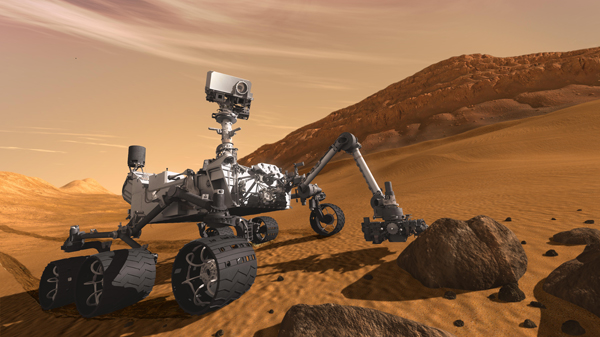 |
| Safely on the surface of Mars, the Curiosity rover begins its long-awaited exploration of the red planet. (Credit: NASA) |
The final stages of the entry, descent and landing sequence will be especially tense as the rover, dubbed Curiosity in a student naming contest, is gently lowered to the surface on cables suspended from a rocket-powered "sky crane" making its debut flight.
Too large to use airbags like those that cushioned NASA's Pathfinder, Spirit and Opportunity rovers, Curiosity will rely instead on landing rockets positioned above the rover, avoiding the challenge of coming up with a reliable way to get a one-ton vehicle off of an elevated, possibly tilted lander. Instead, Curiosity will be set down on its six 20-inch-wide wheels, ready to roll.
If it works.
An end-to-end flight test was not possible in Earth's gravity, forcing engineers to rely instead on exhaustive component testing, thousands of computer simulations and repeated in-house and independent reviews. Even so, engineers jokingly refer to the computer-controlled entry, descent and landing phase as "six minutes of terror."
"We have done a tremendous amount of entry, descent and landing reviews and tests," Peter Theisinger, the MSL project manager, told reporters earlier this month. "You can't do an end-to-end test because you can't land on Mars on the Earth. But you can do the tests in a piece-wise sense.
"So we have done deployments of the sky crane with test equipment and we have done surface contact testing. We have done radar testing on helicopters and F-18 jets ... to basically test all the components of the sky crane system. So we're confident we've done our due diligence."
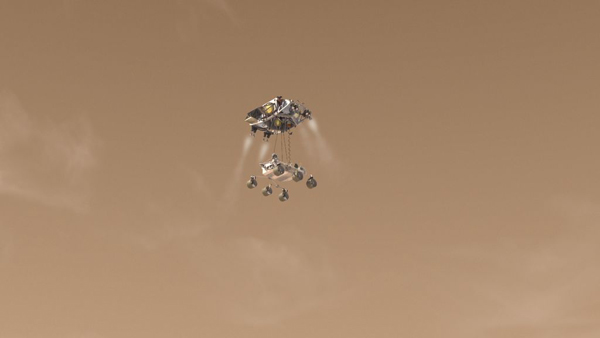 |
| The Curiosity rover is lowered toward the surface by its rocket-power descent stage. (Credit: NASA) |
Even so, Adam Steltzner, a senior EDL engineer at the Jet Propulsion Laboratory in Pasadena, Calif., was only half joking in an earlier interview when he said "if you think about the number of lines of code, the number of circuit elements, number of mechanical fixtures and devices, it actually is completely terrifying."
Getting to Mars has never been easy. The United States has launched 18 missions to the red planet, chalking up 13 successes and five failures, including back-to-back disasters in 1999. The Russians have fared worse, launching nearly 20 missions with only two partial successes to date.
The Russians' latest effort, a $163 million mission designed to land on the martian moon Phobos and send a soil sample back to Earth for analysis, is stranded in low-Earth orbit because of a propulsion system malfunction shortly after launch Nov. 8.
"Mars really is the Bermuda Triangle of the solar system," said Colleen Hartman, assistant associate administrator of NASA's science mission directorate. "It's the 'death planet,' and the United States of America is the only nation in the world that has ever landed and driven robotic explorers on the surface of Mars. And now we're set to do it again."
By using sky crane technology and a new guidance system that allows the rover's flight computer to adjust the entry vehicle's flight path based on actual atmospheric conditions, mission planners were able to select the most scientifically interesting target -- Gale Crater -- from a list of four carefully considered candidates.
Starting on the floor of the vast crater and then slowly ascending the central peak through canyons and ravines visible in orbital photography, "we're basically reading the history of Mars' environmental evolution," said MSL project scientist John Grotzinger.
"We start at the bottom, where ... the clays are, we go up farther, there are the sulfates, and then we go to the top of the mound and we get rocks that we think were formed ... in the drier, more recent phase of Mars," he said.
Climbing the central peak with its exposed layers will be "analogous to what you would see in the Grand Canyon," Grotzinger said. "So our rover is going to be like John Wesley Powell going down the Grand Canyon on Mars, looking at this thick stack of strata."
The promise of the mission, he said, is proving that Mars has harbored habitable environments at some point in its history, areas where the three necessities of life -- water, energy and carbon compounds -- existed in concert.
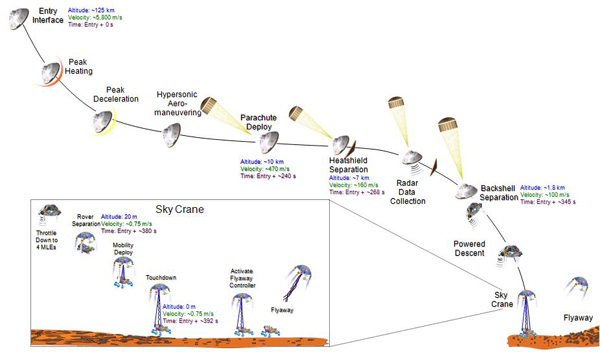 |
| The Mars Science Laboratory will make a rocket-assisted "sky crane" landing on Mars, a complex entry, descent and landing that engineers jokingly refer to as "six minutes of terror." (Credit: NASA) |
The first two are now well established, thanks to earlier Mars missions that showed Mars was once a much warmer, wetter world. But the search for carbon compounds is a much more challenging proposition.
"The promise of Mars Science Laboratory, assuming that all things behave nominally, is we can deliver to you a history of formerly, potentially habitable environments on Mars," Grotzinger said. "But the expectation that we're going to find organic carbon, that's the hope of Mars Science Laboratory. It's a long shot, but we're going to try."
NASA had hoped to launch the MSL mission in 2009, but the flight was delayed two years, at a cost of nearly $500 million, because of a tight schedule and a variety of technical and workmanship issues, including problems with the actuators used in multiple drive mechanisms.
But those issues have been resolved and after a day off for Thanksgiving, NASA and United Launch Alliance plan to haul the rover, packed origami-like into the nose cone of an Atlas 5 rocket, to launch complex 41 at the Cape Canaveral Air Force Station. Liftoff is targeted for 10:02 a.m. EST (GMT-5), the opening of a one-hour 43-minute launch window.
Going into the holiday break, there were no technical problems of any significance with the rocket or its costly payload and forecasters were predicting a 70 percent chance of good weather Saturday and Sunday.
"It feels tremendous to have completed all this work and to have the risk situation ... in very good shape," Theisinger said Wednesday. "Not perfect. Obviously, there is major risk to these things, but we're in pretty good shape."
Here is a timeline of major countdown milestones and ascent events (in EST):
..HH:MM...EST...........COUNTDOWNCuriosity is the size of a small car and weighs 1,982 pounds. It is equipped with 17 cameras, a seven-foot-long robot arm and a suite of 10 state-of-the-art scientific sensors and experiments weighing 125 pounds. In contrast, NASA's hugely successful Mars Exploration Rovers, Spirit and Opportunity, each weighed about 385 pounds, including just 20 pounds of miniaturized science hardware.
T-06:20...03:02:00 AM...Countdown begins
T-04:55...04:27:00 AM...Start clearing vehicle assembly building area
T-04:20...05:02:00 AM...C-band tracking beacon testing
T-03:40...05:42:00 AM...S-band telemetry link checks
T-02:55...06:27:00 AM...Establish blast danger area roadblocks
T-02:20...07:02:00 AM...Weather briefing
T-02:15...07:07:00 AM...Clear the pad
T-02:00...07:22:00 AM...T-minus 2 hour hold (30 min) (Launch-2:40)
T-02:00...07:30:00 AM...NASA TV coverage begins
T-02:00...07:47:00 AM...Launch conductor briefing to team (L-2:15)
T-02:00...07:49:00 AM...Readiness poll for fueling (L-2:13)
T-02:00...07:52:00 AM...Resume countdown
T-01:50...08:02:00 AM...Centaur liquid oxygen transfer line chilldown
T-01:43...08:09:00 AM...Begin Centaur liquid oxygen loading
T-01:30...08:22:00 AM...Begin Atlas first stage liquid oxygen loading
T-01:25...08:27:00 AM...Centaur liquid hydrogen transfer line chilldown
T-01:10...08:42:00 AM...Centaur RL10 engine chilldown
T-01:02...08:50:00 AM...Begin Centaur liquid hydrogen loading
T-00:40...09:12:00 AM...Flight termination system final test
T-00:16...09:36:00 AM...RD-180 engine fuel fill sequence begins
T-00:10...09:42:00 AM...Weather briefing
T-00:04...09:48:00 AM...T-minus 4 minute hold (10 min)
T-00:04...09:49:00 AM...NASA launch manager readiness poll
T-00:04...09:56:00 AM...Spacecraft to internal power
T-00:04...09:58:00 AM...Resume countdown
..MM:SS.................ASCENT EVENTS
T-00:02...10:01:57 AM...RD-180 engine ignition
T+00:00...10:02:00 AM...T-0 (engine ready)
T+00:01...10:02:01 AM...Liftoff
T+00:02...10:02:02 AM...Full thrust
T+00:05...10:02:05 AM...Begin pitch/yaw/roll maneuver
T+00:34...10:02:34 AM...Mach 1
T+00:46...10:02:46 AM...Maximum dynamic pressure
T+00:50...10:02:50 AM...Launch vehicle impact point off shore
T+01:52...10:03:52 AM...Solid rocket booster jettison
T+03:24...10:05:24 AM...Payload fairing jettison
T+03:47...10:05:47 AM...Begin 4.6 g-limiting
T+04:21...10:06:21 AM...Atlas booster engine cutoff (BECO)
T+04:27...10:06:27 AM...Atlas booster/Centaur separation
T+04:37...10:06:37 AM...Centaur first main engine start (MES1)
T+11:29...10:13:29 AM...Centaur first main engine cutoff (MECO1)
T+31:04...10:33:04 AM...Centaur second main engine start (MES2)
T+39:05...10:41:05 AM...Centaur second main engine cutoff (MECO2)
T+42:47...10:44:47 AM...Spacecraft separation
T+43:47...10:45:47 AM...MSL X-band transmitter on/warm up
T+48:47...10:50:47 AM...MSL telemetry transmission begins
And unlike Spirit and Opportunity, which relied on solar arrays for power, Curiosity is equipped with a radioisotope thermoelectric generator, or RTG, that uses thermocouples to convert the heat of radioactive decay into electricity. Excess heat will be used to keep the spacecraft's sensitive systems warm in the frigid Martian environment.
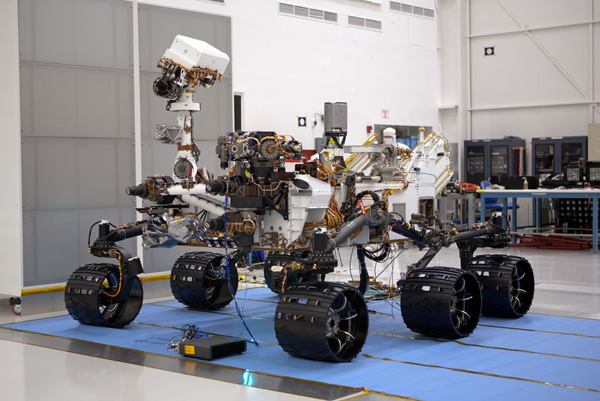 |
| The Curiosity rover during assembly and checkout. (Credit: NASA) |
Spirit and Opportunity had to shut down at night and hunker down in the brutally cold martian winter when the distant sun was lower on the horizon, reducing the electrical output from the arrays. Curiosity can operate day or night, roving at least 12 miles over the course of a martian year. Top speed: one tenth of a mile per hour.
Operating as a mobile science lab, Curiosity will collect thousands of high resolution wide-angle and telephoto photographs of the Gale Crater strata and environs, measure the radiation environment and operate as a weather station using instruments and sensors provided by Spain.
The Sample Analysis at Mars, or SAM, instrument will use a gas chromatograph, a mass spectrometer and a laser spectrometer to study soil samples delivered by the rover's robot arm to look for signs of organic compounds and to measure the the abundance of isotopes of elements that played key roles in the martian environment.
An instrument known as CheMin will will analyze soil samples delivered by the robot arm to identify the minerals present and a microscope on the robot arm, called the Mars Hand Lens Imager, will take closeup images of target rocks and soils.
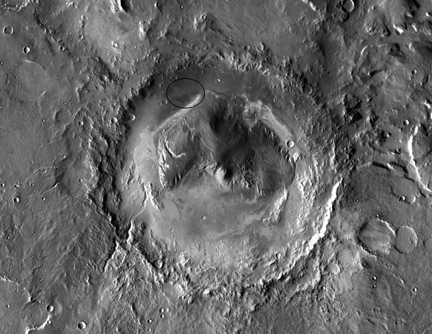 |
| NASA's Mars Science Laboratory rover will land in Gale Crater, where orbital reconnaissance shows a wide range of rock and soil types. The landing zone is circled.(Credit: NASA) |
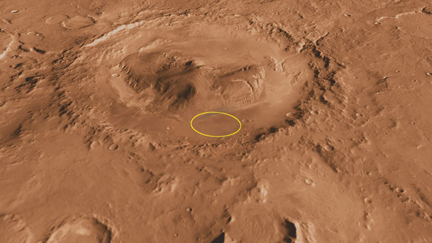 |
| An oblique view of the Gale Crater landing site. (Credit: NASA) |
"This rover, the Curiosity rover, is really a rover on steroids," said Hartman. "It's an order of magnitude more capable than anything we have ever launched to any planet in the solar system. It will go longer, it will discover more than we can possibly imagine."
Doug McCuistion, director of the Mars Exploration Program at NASA Headquarters in Washington, said in an earlier interview that Curiosity "is the most important mission the Mars program has ever flown since Viking [in the mid-1970s]."
"This has the potential to not only revolutionize our scientific understanding of the planet, but it also has the potential to change our engineering capabilities for planetary exploration, even beyond Mars.
"This technique is very different -- guided entry and sky crane," McCuistion said. "It sets the stage for large masses to the surface for the first time, which means we can put a lot of things down we wouldn't have dreamed of putting down over the last 20 years.
"So it is a major step forward, it's a quantum leap instead of an incremental step. Scientifically, I anticipate this will push us from a 'follow the water' strategy to...a 'seeking the signs of life' strategy. I really think it's going to change our focus."
NASA's twin Viking landers touched down on Mars in 1976, photographing their landing sites in unprecedented detail, studying the Martian weather and carrying out sophisticated experiments to look for signs of biological activity. No clear evidence was found and NASA later shifted its emphasis to understanding the role water played in the evolution of the Martian environment.
Thanks to the Mars Pathfinder, Spirit, Opportunity, and the Phoenix polar lander, along with a half-dozen orbiting spacecraft, NASA's follow-the-water strategy paid off. Scientists now know that Mars once enjoyed a warmer, much wetter climate in the distant past, including what may have been a huge ocean in the northern hemisphere.
The question now is whether organic compounds -- the building blocks of life as it is known on Earth -- were present and whether any habitable environments emerged and persisted long enough for life to evolve.
"You've got to have water for life as we know it," Grotzinger told CNET in an earlier interview. "The second thing is you need a source of energy. ... And then the important thing is, you need the fundamental building block, which is carbon."
Until recently, there was no direct evidence of carbon compounds on Mars. Now, Grotzinger said, there are two lines of evidence.
"One is measurements from Earth that suggests there may be methane in the atmosphere," he said. "And the second thing is that based on orbiter missions, people have discovered rocks that are made out of carbonate minerals. So you see it in rocks, you see it in the atmosphere, so it's reasonable to propose that we have all of the three key ingredients that we need in order for life to exist."
But finding the carbon compounds may be a challenge.
"A wise friend of mine once told me don't promise more than you can deliver," Grotzinger said Wednesday. "We're on a mission to look for organic carbon. The information from orbit looks so darn good now, based on all the previous program successes, I'd be surprised if we landed on the surface and didn't find something that looked like it could have been a formerly habitable environment.
"But if you're trying to get me to say what are the chances of finding organic carbon, I'd say it's like looking for a needle in a haystack. And the haystack is as big as a football field."